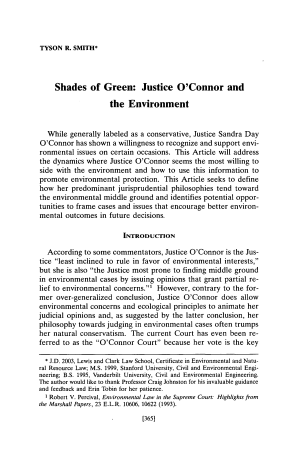Shades of Green: Justice O'Connor and the Environment
September 1, 2003

DISCLAIMER: This text has been transcribed automatically and may contain substantial inaccuracies due to the limitations of automatic transcription technology. This transcript is intended only to make the content of this document more easily discoverable and searchable. If you would like to quote the exact text of this document in any piece of work or research, please view the original using the link above and gather your quote directly from the source. The Sandra Day O'Connor Institute does not warrant, represent, or guarantee in any way that the text below is accurate.
Article Text
(Excerpt, Automatically generated)
TYSON R. SMITH*
Shades of Green: Justice O'Connor and the Environment
While generally labeled as a conservative, Justice Sandra Day O'Connor has shown a willingness to recognize and support envi ronmental issues on certain occasions. This Article will address the dynamics where Justice O'Connor seems the most willing to side with the environment and how to use this information to promote environmental protection. This Article seeks to define how her predominant jurisprudential philosophies tend toward the environmental middle ground and identifies potential oppor tunities to frame cases and issues that encourage better environ mental outcomes in future decisions.
INTRODUCTION
According to some commentators, Justice O'Connor is the Jus tice "least inclined to rule in favor of environmental interests," but she is also "the Justice most prone to finding middle ground in environmental cases by issuing opinions that grant partial re lief to environmental concerns."1 However, contrary to the for mer over-generalized conclusion, Justice O'Connor does allow environmental concerns and ecological principles to animate her judicial opinions and, as suggested by the latter conclusion, her philosophy towards judging in environmental cases often trumps her natural conservatism. The current Court has even been re ferred to as the "O'Connor Court" because her vote is the key
- J.D. 2003, Lewis and Clark Law School, Certificate in Environmental and Natu ral Resource Law; M.S. 1999, Stanford
